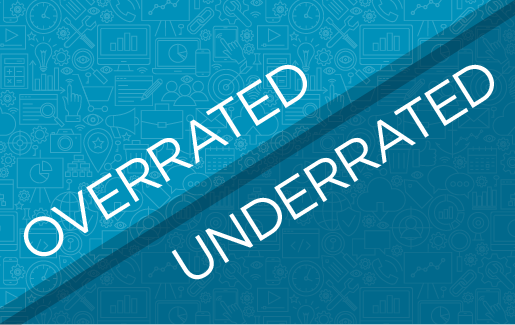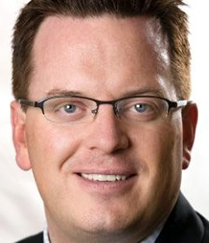
Welcome to Overrated/Underrated, a column featuring CompTIA members and experts sharing which tech trends are getting more buzz than they might deserve and which ones aren't getting enough. This month, we talked to Ryan Morris, principal consultant at Morris Management Partners, Inc., a consulting and business development firm serving IT channel companies.
CompTIA: You posited that the merging worlds of IT and OT—or operational technology, specifically digital twin technology—is underrated. Let’s start by outlining the issue.
 Ryan Morris: It starts with a basic definition. Everyone in our industry was born and raised to manage information technology. So as a category, that's the scope of what we typically pay attention to.
Ryan Morris: It starts with a basic definition. Everyone in our industry was born and raised to manage information technology. So as a category, that's the scope of what we typically pay attention to.
The other side of the customers’ world, however, is that what I refer to as OT or operational technologies, and that gets into the category of equipment and systems that are used to do labor. But it's also associated with the systems of a building and the machinery on a factory floor or the pump drilling into the ground. The key is that the operational technology is, in many cases, older than a lot of the information technology companies use and those systems in place need to be retrofitted for internet connectivity. What's changed is that when all of that equipment is connected to the internet it will run on an operating system, use a processor, have a hard drive and connect to the network for programming, control and automation purposes as well as for information gathering and analytical purposes.
CompTIA: How should a technology professional be looking at this topic?
RM: I think the first part of the conversation is that we have a blind spot to the world of operational technologies. But it actually looks like a missed opportunity, right? Especially if I'm a managed service provider and my job is to monitor, manage and report on anything that attaches to the network. Well, it's no longer just the servers and the laptops and somebody's smartphone. As we move into more of the modern definition of IoT, all of the things in this world that have a processor, internet connection, and a sensor to capture and track local information—those things all become opportunities.
CompTIA: Where should we begin to think about IT and OT opportunities?
RM: Many years ago, a very smart person in this industry told me that the best way to understand our role with customers is that anything that connects to the network is something we should be aware of and getting paid to sell and support.
I think that's the first thing we need to explore—the old-fashioned definition of our job is only to sell and support information technology. I would argue the best way to think of our role is to help our customers use technology to achieve operational or business benefits. Take the information technology or operational technology out of it and just say, “If it’s connected to the network, that's something we should be in charge of.”
CompTIA: If IoT already exists, isn’t the merging of IT and OT already an obvious next step? Why do you think it's underrated?
RM: I believe it's underrated because it’s a blind spot in our own definition of the job we do. The work we do has been defined by people who run computers. And that's great—we provide a service to a customer that is valuable, necessary and lasts over time. But why would we not also apply that same mentality to the other side of our customers’ businesses?
If we only pursue the IT side of the business, we're missing out on more than half the opportunities with a single customer. Many analysts have predicted that billions of new connected devices will use the internet and share information in real time in just the next few years; those billions of devices represent economic opportunity for your company. We need to open our eyes and ask, “What else are our customers doing that's connected to the internet?”
CompTIA: What happens if the industry is slow to adopt or accept IT/OT merging worlds?
RM: Here’s an example: Everybody's familiar with the major hack that happened at Target. And when you talk about the Target hack, the point everybody makes is that they didn't get in through a PC or a server. They got in through a subcontractor who was working on the HVAC system that is connected to the internet—it was a portal into all of its other data systems.
If we don't pay attention to those things, not only are they missed business opportunities, but they remain unguarded, unmanaged security risks. All of the people who monitor and manage technology systems, if they don't stay up to date with the new endpoint devices that are connecting to the network, they will get left behind.
CompTIA: Let’s talk about digital twin technology. I understand it to be like NASA building a virtual space station before a launch to help test the technology. How do small businesses or MSPs use digital twin technology?
RM: It sounds like science fiction, but when you get the concept you realize this is the byproduct of IoT—in order for devices to be discoverable and manageable, we need to understand what they are and how they are performing in the field. A digital twin is a digital representation of a physical system or device that lives in the real world. And that concept can be applied to everything—such as the overall layout of an oil field operational system and all of the pumps, transmission lines and refining stations, and all of the packaging and transport capabilities.
But you will also find that the concept of a digital twin applies to simple devices. One of the best ways I heard it explained was this: Imagine that you buy a bicycle. The bike comes with an owner's manual that gives you general instructions for how to maintain or repair it if something goes wrong. Those instructions are based on the idea that every bike from that manufacturer purchased by any customer in any scenario is identical—you use the same set of instructions to fix your bike that I would use to fix mine.
But in the world of a digital twin, that bike lives in the real world, and there's also a digital representation of it on the network. Say something goes wrong with your bike and you need to take it into a shop and get some service performed. Well, the technician, no matter how much experience they have, can only begin from the definition of the generic. And then they have to do a whole diagnostic of, “Okay, what happened to it, what's broken, and why is it not working properly?” Once they discover what the real problem is, they can set about fixing that thing.
With a digital twin, the technician would scan a QR code and identify your specific bike. The sensor data associated with it becomes instantly available to them. Instead of spending hours trying to figure out what's wrong with your bike, it can be fixed in a matter of minutes.
The bike repair technician would not only be more accurate and solve the real problem instead of just tinkering around, but they would also be able to charge higher rates for fixing your bike in less time. Now, their business is radically more efficient. Your bike is much better maintained and managed. Everybody wins. Well, when you take that kind of a concept, and think about it locally at the individual object level—in a digital twin environment, everything can be connected via sensor and a radio to the internet, right? It has local knowledge of its own systems and functionality. It connects to the internet and it can transmit that data.
CompTIA: What are the challenges of the digital twin technology?
RM: Ethics, security and privacy take this concept out of a conversation about an opportunity or a possibility and make it a mandatory responsibility for technology professionals. It would be irresponsible to deploy one of these systems and not put it inside the network security umbrella. It would be irresponsible to capture and transmit that data about your bicycle, about your car, about your house, about your personal health, without assurance that the data is encrypted, that the systems are locked down and private, that none of your personally identifiable information can ever be shared without proper security protocols.
CompTIA: So digital twin technology can—and will be—a major opportunity for those who approach it with forethought and consideration for ethics and security.
RM: I would buy all of the smart technologies tomorrow if they could convince me that they were secure. I believe it's an ethical responsibility for technology professionals. The reason CompTIA has an Emerging Technologies Community is that these things are coming. Not only should it be our responsibility, it needs to be our responsibility. And that responsibility will include exponential growth in business opportunities for channel companies.
Connect with Ryan on LinkedIn.
Want to share your opinion about an over-hyped or under-the-radar tech trend? Email [email protected] if you'd like to contribute to Overrated/Underrated.

 Add CompTIA to your favorite RSS reader
Add CompTIA to your favorite RSS reader

